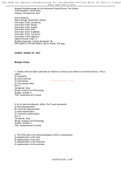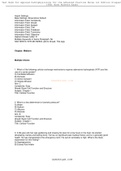NURS 502
St. Thomas University ( )
Page 4 out of 51 results
Sort by

-
Test Bank for Applied Pathophysiology for the Advanced Practice Nurse 1st Edition Dlugasch(Test Bank PDF Files)Applied Pathophysiology for the Advanced Practice Nurse, First EditionLucie Dlugasch, Lachel StoryChapter 4 Assessment Quiz
- Exam (elaborations) • 10 pages • 2023
- Available in package deal
-
- $10.49
- + learn more
Chapter: Chapter 04 - Quiz Multiple Choice 1. Cardiac cells are able to generate an impulse to contract even without an external stimulus. This is called: A) excitability. B) action potential. C) automaticity. D) chronotropic effect. Ans: C Complexity: Easy Ahead: Anatomy and Physiology Subject: Chapter 4 Title: Cardiovascular Function 2. On an electrocardiogram (EKG), the P wave represents: A) atrial depolarization. B) ventricular depolarization. C) atrial repolarization. D) ve...

-
Applied Pathophysiology for the Advanced Practice Nurse, First Edition Lucie Dlugasch, Lachel Story Chapter 2 Assessment Quiz
- Exam (elaborations) • 6 pages • 2023
- Available in package deal
-
- $9.49
- + learn more
Chapter: Chapter 02 - Quiz Multiple Choice 1. A patient who has seasonal allergic rhinitis is having a flare up and is complaining of sneezing and a watery, runny nose (rhinorrhea). The patient is prescribed an antihistamine. The expected effect of this medication is to: A) promote blood flow to the area to remove inflammatory mediators. B) promote smooth muscle contraction thereby improving drainage. C) decrease vascular permeability to decrease rhinorrhea. D) increase vascular permeabi...

-
Applied Pathophysiology for the Advanced Practice Nurse, First EditionLucie Dlugasch, Lachel StoryChapter 1 Assessment Quiz
- Exam (elaborations) • 8 pages • 2023
- Available in package deal
-
- $9.49
- + learn more
Chapter: Chapter 01 - Quiz Multiple Choice 1. Protein hormones and enzymes are stored in the __________, awaiting signals to be released into the cell. A) food vacuole B) Golgi complex C) rough endoplasmic reticulum D) secretory vesicles Ans: D Complexity: Easy Ahead: Basic Cell Function and Structure Subject: Chapter 1 Title: Cellular Function 2. Low serum albumin levels (hypoalbuminemia) can cause edema because: A) oncotic pressure increases. B) oncotic pressure decreases. C) o...

-
NURS 502 MIDTERM Exam.
- Exam (elaborations) • 13 pages • 2023
-
- $9.49
- 1x sold
- + learn more
Chapter: Midterm Multiple Choice 1. Which of the following cellular exchange mechanisms requires adenosine triphosphate (ATP) and the use of a carrier protein? A) Facilitated diffusion B) Osmosis C) Active transport D) Simple diffusion Ans: C Complexity: Easy Ahead: Basic Cell Function and Structure Subject: Chapter 1 Title: Cellular Function 2. What is a key determinant of osmotic pressure? A) Water B) Sodium C) Albumin D) Glucose Ans: B Complexity: Easy Ahead: Basic Cell Fu...

-
Applied Pathophysiology for the Advanced Practice Nurse, First Edition Lucie Dlugasch, Lachel Story Chapter 11 Assessment Quiz
- Exam (elaborations) • 10 pages • 2022
-
- $10.49
- + learn more
Chapter: Chapter 11 - Quiz Multiple Choice 1. Neuroanatomic and neurotransmitter alterations in the pathophysiology of schizophrenia include which of the following? A) Loss of cortical tissue B) Alteration in dopamine pathways C) Shrinkage of the ventricles D) All of these are correct. E) Loss of cortical tissue and alteration in dopamine pathways Ans: E Complexity: Easy Ahead: Mental Health Disorders Subject: Chapter 11 Title: Neural Function 2. A patient reports that he senses th...

-
Applied Pathophysiology for the Advanced Practice Nurse, First Edition Lucie Dlugasch, Lachel Story Chapter 13 Assessment Quiz
- Exam (elaborations) • 6 pages • 2022
-
- $10.49
- + learn more
Chapter: Chapter 13 - Quiz Multiple Choice 1. Which cells of the dermis release histamine? A) Mast cells B) Eosinophils C) Macrophages D) Histiocytes Ans: A Complexity: Easy Ahead: Inflammatory Integumentary Disorders Subject: Chapter 13 Title: Integumentary Function 2. Basal cell carcinoma: A) has a high metastasis potential. B) can cause significant local tissue destruction. C) is usually not nodular. D) is often preceded by actinic keratosis. Ans: B Complexity: Easy Ahead: ...

-
Applied Pathophysiology for the Advanced Practice Nurse, First Edition Lucie Dlugasch, Lachel Story Chapter 8 Assessment Quiz
- Exam (elaborations) • 10 pages • 2022
-
- $11.49
- + learn more
Chapter: Chapter 08 - Quiz Multiple Choice 1. The sex hormone–binding globulin (SHBG) on a laboratory analysis is a reflection of the amount of: A) unbound testosterone in body tissues. B) free testosterone in body tissues. C) bound testosterone in body tissues. D) biologically active testosterone in body tissues. Ans: C Complexity: Easy Ahead: Anatomy and Physiology Subject: Chapter 8 Title: Reproductive Function 2. Proper erectile functioning requires: A) sympathetic stimulation...

-
9781284150476_ASQZ_CH14.Applied Pathophysiology for the Advanced Practice Nurse, First Edition Lucie Dlugasch, Lachel Story Chapter 14 Assessment Quiz
- Exam (elaborations) • 5 pages • 2022
-
- $11.49
- + learn more
Chapter: Chapter 14 - Quiz Multiple Choice 1. A 6-year-old child is brought to the pediatric clinic with an eye problem. The child is diagnosed with viral conjunctivitis. What is important information to discuss with the parents and child? A) The importance of compliance with antibiotic therapy B) The importance of surgery to prevent scarring of the conjunctiva C) The condition is highly contagious and hand washing is extremely important D) The signs and symptoms of complications such as ...

-
MIDTERM Exam >Applied Pathophysiology for the Advanced Practice Nurse 1st Edition Dlugasch Test Bank
- Exam (elaborations) • 13 pages • 2022
-
- $10.49
- + learn more
1. Which of the following cellular exchange mechanisms requires adenosine triphosphate (ATP) and the use of a carrier protein? A) Facilitated diffusion B) Osmosis C) Active transport D) Simple diffusion Ans: C Complexity: Easy Ahead: Basic Cell Function and Structure Subject: Chapter 1 Title: Cellular Function 2. What is a key determinant of osmotic pressure? A) Water B) Sodium C) Albumin D) Glucose Ans: B Complexity: Easy Ahead: Basic Cell Function and Structure Subject: Chap...

-
Applied Pathophysiology for the Advanced Practice Nurse, First Edition Lucie Dlugasch, Lachel Story Chapter 9 Assessment Quiz
- Exam (elaborations) • 8 pages • 2022
-
- $10.49
- + learn more
Chapter: Chapter 09 - Quiz Multiple Choice 1. Where does nutrient absorption begin? A) Esophagus B) Stomach C) Small intestine D) Large intestine Ans: C Complexity: Easy Ahead: Anatomy and Physiology Subject: Chapter 9 Title: Gastrointestinal Function 2. Which cranial nerve controls intestinal motility? A) Trigeminal B) Glossopharyngeal C) Hypoglossal D) Vagus Ans: D Complexity: Easy Ahead: Anatomy and Physiology Subject: Chapter 9 Title: Gastrointestinal Function 3. Which ...

How did he do that? By selling his study resources on Stuvia. Try it yourself! Discover all about earning on Stuvia


